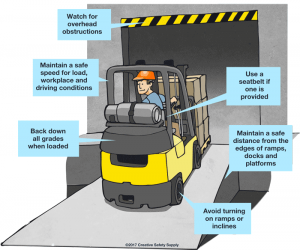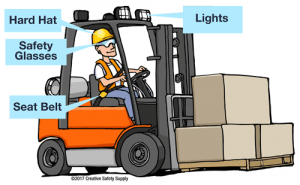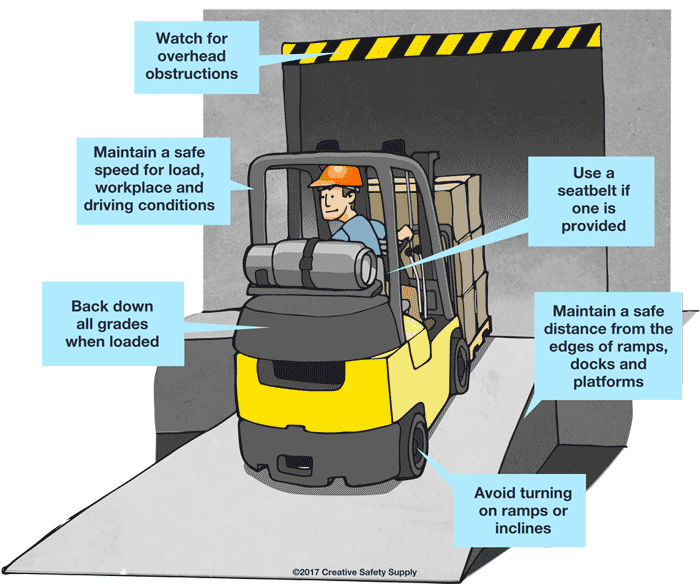Even More About Forklift Safety
The forklift is the Swiss army knife of material handling. It is so versatile that it can carry just about any product known to man and any shape that man’s imagination can make.
However, they can also be dangerous if not properly operated. Thousands of people are injured or killed during a year due to sloppy driver activity.
Improvements In Forklift Safety
Evolutionary changes have been made to the lift to assure that they operate safely. They include:
• Technology innovations including self-driving lifts that may dramatically reduce injuries.
• Better design. Forklifts have been better designed prior to manufacturing allowing such improvements as better visibility that reduces the possibility of accidents.
Another improvement that has not involved lift manufacturers that result in safer activity is better visual communication between the forklift operator and employees who work in close proximity to forklifts. Warehouse executives have done a good job educating drivers and workers on what to watch out for. More warehouses are using floor markings to ensure that drivers keep their lift in specific areas.
Another improvement initiated by warehouse managers is better forklift training. Drivers are being taught to avoid accidents, pinch points, and common risks involved in forklift operation.
Hazards That Affect Forklift Operation
One way to ensure forklift safety is to be proactive. Forklift drivers and fleet managers can work together to identify possible hazards associated with lift operation and then take steps to minimize those risks.
Driver And Manager Responsibility
Forklift safety can be ensured if forklift operators take responsibility. For example, they should identify blind spots on the lift and come up with procedures to overcome them. Blind spots are a common reason for forklift-related accidents. Drivers can take responsibility to make things safer for the warehouse employees as a whole.
Drivers need to also be observant. For example, the condition of the floor on which the lift moves constantly changes. There could be debris that drivers will need to avoid, wet conditions that could cause the tires to slip, and route changes that drivers need to be aware of.
Warehouse executives must also take responsibility to ensure safety. For example, it’s up to executives to assign proper speed limits to ensure safety. Speed limits should be promoted with proper signage.
Warehouse management should also be lenient about allowing forklift drivers to rest when they’re tired. Just as one becomes tired after driving a car for several consecutive hours, a forklift driver also suffers fatigue after hours of driving and should be allowed to take a break.
Other issues in which drivers and managers need to share responsibility include anticipating carbon monoxide poisoning and laying out visual markings so that the drivers are aware where they should go and where they shouldn’t. Many forklifts are powered by propane that can emit carbon monoxide. The area in which the lift is operated should include proper ventilation to prevent poisoning. In addition, visual markings should include the defining of aisles, stop signs, etc.
Managers should perform regular evaluation of the work place to determine how they can improve safety procedures that avoid mistakes.
Workplace Surroundings
Another issue that may be more for the warehouse managers than the forklift drivers is hazards that exist in the workplace environment. Forklift drivers have to operate their machines in different conditions and different locations. This presents different risks.
One issue that commonly arises is operating a lift in a small or narrow area. A poorly performed turn can result in damage to property or causing products to fall from the lift, resulting in injuries. All lift drivers must be aware how to negotiate small or narrow spaces to avoid accidents that can harm fellow workers.
Personal Protective Equipment 
Although accidents happen, personal protective equipment worn by personnel can assure that injuries don’t occur.
Safety equipment associated with a forklift that should be in use in a warehouse include:
• Safety straps or seatbelts that prevent drivers from falling from a lift.
• Hard hats that protect forklift operators from getting hit over the head by falling objects or hazards.
• Eye protection that guards such things as dust or debris from injuring eyes.
• Lights on the lift as well as lights or reflective personal protective equipment worn by people who work around forklifts. These things assure that forklift operators see their co-workers.
Proper OSHA Signage
Finally, the Occupational Safety And Health Administration (OSHA) is one of the government agencies that regulate warehouse and forklift operations. It offers safety signage to warehouses that help to assure a safe operation. It is up to the warehouse manager to be aware of OSHA signage requirements. Through consulting with OSHA, you can learn the required components of OSHA safety signs as well as tips on how to format and post the signs.
Using these tips should help you create a comprehensive safety program that will prevent accidents and injuries from occurring.
(Source: creativesafetysupply.com)

